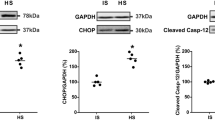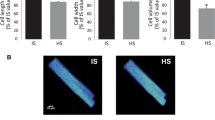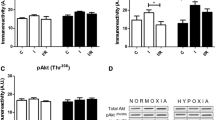Abstract
Osmolytes are rapidly lost from the ischemic heart, an effect thought to benefit the heart by reducing the osmotic load. However, the observation that chronic lowering of one of the prominent osmolytes, taurine, is more beneficial to the ischemic heart than acute taurine loss suggests that osmotic stress may benefit the ischemic heart through multiple mechanisms. The present study examines the possibility that chronic osmotic stress preconditions the heart in part by stimulating a cardioprotective, osmotic-linked signaling pathway. Hyperosmotic stress was produced by treating rat neonatal cardiomyocytes during the pre-hypoxic period with either the taurine depleting agent, #x003B2;-alanine (5 mM), or with medium containing 25 mM mannitol. The cells were then subjected to chemical hypoxia in medium containing 3 mM Amytal and 10 mM deoxyglucose but lacking #x003B2;-alanine and mannitol. Cells that had been pretreated with either 5 mM #x003B2;-alanine or 25 mM mannitol exhibited resistance against hypoxia-induced apoptosis and necrosis. Associated with the osmotically preconditioned state was the activation of Akt and the inactivation of the pro-apoptotic factor, Bad, both events blocked by the inhibition of PI 3-kinase. However, preconditioning the cardiomyocyte with mannitol had no effect on the generation of free radicals during the hypoxic period. Osmotic stress also promoted the upregulation of the anti-apoptotic factor, Bcl-2. Since inhibition of PI 3-kinase with Wortmannin also prevents osmotic-mediated cardioprotection, we conclude that hyperosmotic-mediated activation of the PI 3-kinase/Akt pathway contributes to osmotic preconditioning. (Mol Cell Biochem 269: 59–67, 2005)
Similar content being viewed by others
References
Cohen MV, Baines CP, Downey JM: Ischemic preconditioning: From adenosine receptor to KATP channel. Annu Rev Physiol 62: 79–109, 2000
O’Rourke B: Myocardial KATP channels in preconditioning. Circ Res 87: 845–855, 2000
Murry CE, Jennings RB, Reimer KA: Preconditioning with ischemia: A delay of lethal cell injury in ischemic myocardium. Circulation 74: 1124–1136, 1986
Fryer RM, Hsu AK, Gross GJ: Mitochondrial KATP channel opening is important during index ischemia and following myocardial reperfusion in ischemic preconditioned rat hearts. J Mol Cell Cardiol 33: 831–834,~2001
Garcia-Dorado D, Oliveras J: Myocardial oedema: A preventable cause of reperfusion injury? Cardiovasc Res 27: 1555–1563, 1993
Falck G, Schjott J, Jynge P: Hyperosmotic pretreatment reduces infarct size in the rat heart. Physiol Rev 48: 331–340, 1999
Kloner RA, Reimer KA, Willerson JT, Jennings RB: Reduction of experimental myocardial infarct size with hyperosmotic mannitol. Proc Soc Exp Biol Med 151: 677–683, 1976
Tranum-Jensen J, Janse MJ, Fiolet JWT, Krieger JG, D’Alnoncourt CN, Durrer D: Tissue osmolality, cell swelling, and reperfusion in acute regional myocardial ischemia in the isolated porcine heart. Circ Res 49: 364–381, 1981
Harada RN, Limm W, Piette LH, McNamara JJ: Failure of mannitol to reduced myocardial infarct size in the baboon. Cardiovasc Res 76: 893–896, 1992
Klein HH, Nebandahl KN, Schubothe M, Kreuzer H: Intracoronary hyperosmotic mannitol during reperfusion does not affect infarct size in ischemic, reperfused porcine hearts. Basic Res Cardiol 80: 251–259, 1985
Krause U, Rider MH, Hue L: Protein kinase signaling pathway triggered by cell swelling and involved in the activation of glycogen synthase and acetyl CoA carboxylase in isolated rat hepatocytes. J Biol Chem 271: 16668–16673, 1996
Low SY, Rennie MJ, Taylor PM: Signaling elements involved in amino acid transport responses to altered muscle cell volume. FASEB J 11: 1111–1117, 1997
Good DW, DiMari JF, Watts III BA: Hyposmolality stimulates Na+/H+ exchange and HCO3− absorption in thick ascending limb via PI 3-kinase. Am J Physiol 279: C1443–C1454, 2000
Galvez AS, Ulloa JA, Chiong M, Criollo A, Eisner V, Barros LF, Lavandero S: Aldose reductase induced by hyperosmotic stress mediates cardiomyocyte apoptosis. J Biol Chem 278: 38484–38494, 2003
Meier R, Thelen M, Hemmings BA: Inactivation and dephosphorylation of protein kinase Bα PKBα promoted by hyperosmotic stress. EMBO J 17: 7294–7303, 1998
Zundel W, Giaccia A: Inhibition of the anti-apoptotic PI3K/Akt/Bad pathway by stress. Genes Dev 12: 1941–1946, 1998
Schaffer SW, Ballard Croft C, Solodushko V: Cardioprotective effect of chronic hyperglycemia: Effect on hypoxia-induced apoptosis and necrosis. Am J Physiol 278: H1948–H1954, 2000
Schaffer SW, Solodushko V, Kakhniashvili D: Beneficial effect of taurine depletion on osmotic, sodium and calcium loading. Am J Physiol 282: C1113–C1120, 2002
Allo SN, Bagby L, Schaffer SW: Taurine depletion, a novel mechanism for cardioprotection from regional ischemia. Am J Physiol 273: H1956–H1961, 1997
Fujio Y, Nguyen T, Wencker D, Kitsis RN, Walsh K: Akt promotes survival of cardiomyocytes in vitro and protects against ischemia-reperfusion injury in mouse heart. Circulation 101: 660–667, 2000
Yamashita K, Kajstura J, Discher DJ, Wasserlauf BJ, Bishopric NH, Anversa P, Webster KA: Reperfusion-activated Akt kinase prevents apoptosis in transgenic mouse hearts overexpressing insulin-like growth factor-1. Circ Res 88: 609–614, 2001
Konishi H, Matsuzaki H, Tanaka M, Ono Y, Tokunaga C, Kuroda S, Kikkawa U: Activation of RAC-protein kinase by heat shock and hyperosmolarity stress through a pathway independent of phosphatidylinositol 3-kinase. Proc Natl Acad Sci USA 93: 7639–7643, 1996
Datta SR, Brunet A, Greenberg ME: Cellular survival: A play in three Akts. Genes Dev 1999; 13: 2905–2927
Mehrhof FB, Mueller F-U, Bergmann MW, Li P, Wang Y, Schmitz W, Dietz R, von Harsdorf R: In cardiomyocyte hypoxia, insulin-like growth factor-I-induced antiapoptotic signaling requires phosphatidyl-3-OH-kinase-dependent and mitogen-activated protein kinase-dependent activation of the transcription factor cAMP response element-binding protein. Circulation 104: 2088–2094, 2001
Van der Kaay J, Beck M, Gray A, Downes CP: Distinct phosphatidylinositol 3-kinase lipid products accumulate upon oxidative and osmotic stress and lead to different cellular responses. J Biol Chem 274: 35963–35968, 1999
Pion PD, Kittleson MD, Rogers QR, Morris JG: Myocardial failure in cats associated with low plasma taurine: A reversible cardiomyopathy. Science 237: 764–768, 1987
Schaffer S, Solodushko V, Pastukh V, Ricci C, Azuma J: Possible cause of taurine deficient cardiomyopathy: Potentiation of angiotensin II action. J Cardiovasc Pharmacol 41: 751–759, 2003
Chen Z, Chua CC, Ho Y-S, Hamdy RC, Chua BHL: Overexpression of Bcl-2 attenuates apoptosis and protects against myocardial I/R injury in transgenic mice. Am J Physiol 280: H2313–H2320, 2001
Limana F, Urbanek K, Chimenti S, Quaini F, Leri A, Kajstura J, Nadal-Ginard B, Izumo S, Anversa P: bcl-2 overexpression promotes myocyte proliferation. Proc Natl Acad Sci USA 99: 6257– 6262, 2002
Author information
Authors and Affiliations
Corresponding author
Rights and permissions
About this article
Cite this article
Pastukh, V., Ricci, C., Solodushko, V. et al. Contribution of the PI 3-kinase/Akt survival pathway toward osmotic preconditioning. Mol Cell Biochem 269, 59–67 (2005). https://doi.org/10.1007/s11010-005-2536-z
Received:
Accepted:
Issue Date:
DOI: https://doi.org/10.1007/s11010-005-2536-z




